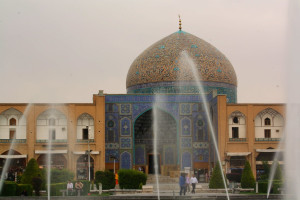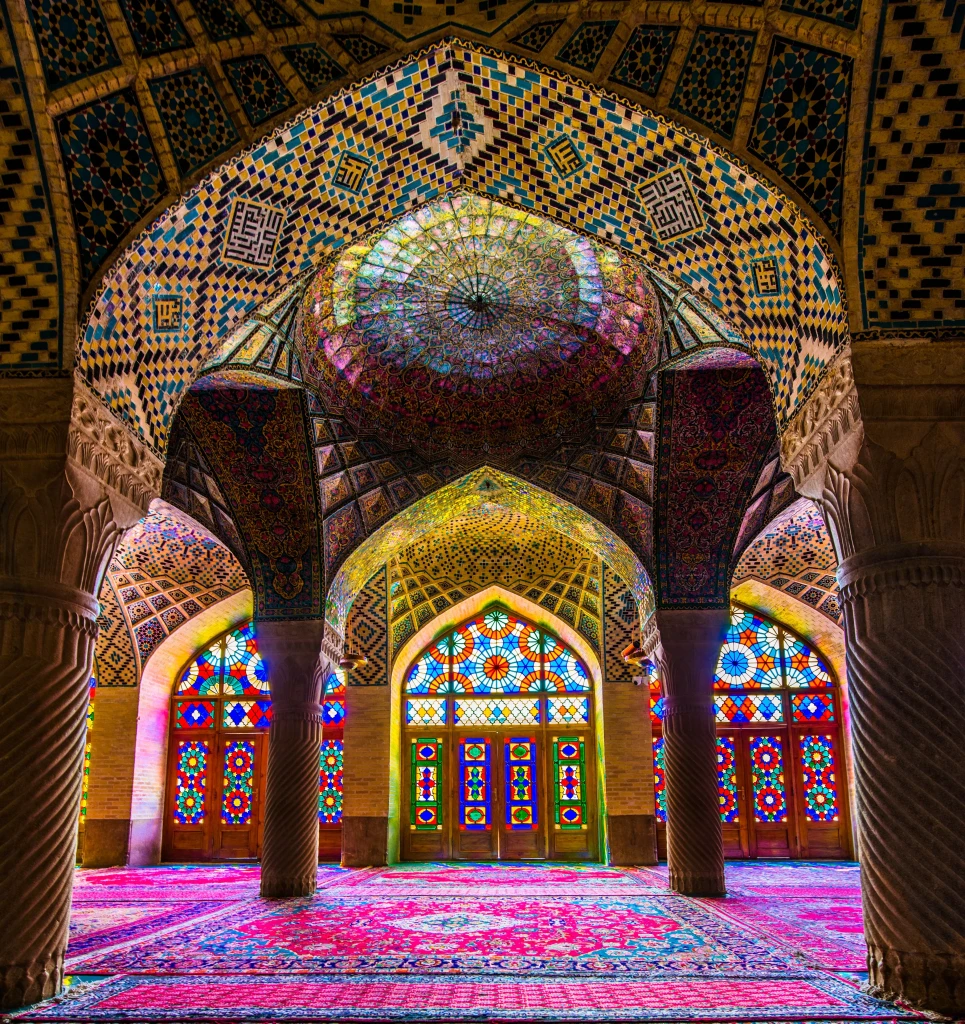Introduction
Persian architecture, a captivating journey through time and artistry, unveils a world of elegance and innovation. From towering domes to enchanting gardens, its allure lies not only in its beauty but also in its reflection of a culture’s soul. As we embark on this exploration, we’ll uncover the magic that Persian architecture weaves and its profound connection to the heart of a people.
Historical Evolution – Persian Architecture
Ancient Persian Architecture: Achaemenid Empire
Let’s begin our journey with a step into the ancient past, where the Achaemenid Empire laid the foundation for Persian architectural marvels. Imagine colossal structures rising from the desert sands, bearing witness to the grandeur of Persepolis and the legacy of Pasargadae. These awe-inspiring sites weren’t just buildings; they were stories etched in stone. Imagine intricate carvings and monumental columns, each telling tales of triumph and unity. The Achaemenid architects, like master storytellers, used every nook and cranny to share their narratives with the world.
Islamic Influence: A Blend of Cultures
As the pages of history turned, the winds of change brought Islam to Persia’s doorstep. This marked a significant shift in architectural styles, as Persian design seamlessly intertwined with Islamic elements. Picture graceful domes adorning mosques, reaching towards the heavens in a gesture of devotion. Islamic artistry found its home in Persian architecture, and the result was nothing short of magical. Geometry took center stage, with mesmerizing patterns and designs dancing across surfaces, creating a sense of harmony and tranquility.
The Age of Windcatchers and Gardens
Now, let’s drift away from the imposing structures for a moment and find ourselves in a world where nature and architecture blend harmoniously. Enter the enchanting realm of windcatchers and gardens. Windcatchers, or “badgirs,” were the ingenious answer to the scorching desert heat. Imagine these elegant structures catching the breeze, channeling it into homes, and creating a cool oasis amidst the arid landscape. And then, there are the gardens—”baghs”—where nature and design coexist in perfect symmetry. Picture serene pools reflecting the sky, surrounded by lush greenery. These gardens weren’t just spaces; they were invitations to find solace and connection with the world around.
The Legacy and Beyond
As Persian architecture journeyed through time, it left its indelible mark on the world. Beyond Iran’s borders, its influence echoed in the intricate designs of the Mughal Empire in India. The Taj Mahal, an epitome of beauty and love, drew inspiration from the graceful arches and ornate calligraphy that Persian architecture embraced. It’s as if the stories that began in the heart of Persia found new chapters across continents, whispering tales of splendor and unity.
The Dance of Styles: Safavid Era to Modern Times
The narrative of Persian architecture continued to evolve with the passage of time. The Safavid era brought forth a fusion of styles, as European influences seeped into the traditional Persian tapestry. Mirrored halls reflected light and imagination, while architectural wonders like Naqsh-e Jahan Square in Isfahan painted a portrait of opulence and artistry. As modern times dawned, Persian architecture embraced new materials and technologies, creating a bridge between past and present.
Architectural Elements – Persian Architecture
Domes and Minarets: Guardians of Persian Mosques
Imagine stepping into the serene sanctuary of a Persian mosque. What catches your eye first? The majestic domes and slender minarets that seem to reach for the heavens. These architectural elements are more than just embellishments; they’re the very essence of Persian mosques. Domes define the skyline, offering a glimpse of the spiritual haven within. Intricate tilework and mesmerizing calligraphy adorn these domes, each tile a brushstroke in a masterpiece of devotion.
Iwans and Courtyards: Where Beauty Meets Purpose
Now, let’s venture deeper into the heart of Persian architecture—the iwans and courtyards. Iwans, those majestic vaulted chambers, serve as gateways to inner sanctums. They’re not just entrances; they’re a marriage of functionality and aesthetics. Imagine seeking refuge from the scorching sun under the shelter of an iwan, the cool breeze whispering stories of the past. And then, there are the courtyards—open spaces where architecture and community intertwine. Imagine gatherings, laughter, and moments of connection unfolding in these serene oases.
Gardens and Water Features: Nature’s Dance with Design
As we continue our exploration, let’s immerse ourselves in the enchanting realm of Persian gardens and water features. These gardens, meticulously designed and carefully tended, are a reflection of nature’s beauty and human ingenuity. Each pathway, each pool, is a brushstroke in a masterpiece that transcends time. But there’s more to these gardens than meets the eye. More than just respite spots, these gardens symbolize paradise here on Earth. And the secret behind their lushness? Qanats—ancient underground channels that brought life-giving water to these paradises.
Signature Structures – Persian Architecture
Nasir al-Mulk Mosque: The Pink Mosque’s Radiant Splendor
Close your eyes and picture a mosque bathed in the soft hues of dawn. That’s Nasir al-Mulk Mosque, also known as the Pink Mosque. But don’t let the name fool you; it’s a symphony of colors that dances upon its walls. Stained glass windows create a mesmerizing interplay of light and color, painting the prayer hall with a kaleidoscope of hues. It’s as if the very sunrises and sunsets of Iran have found their way into the mosque, weaving a tapestry of transcendence and beauty.
Sheikh Lotfollah Mosque: Geometric Elegance
Now, let’s step into the realm of geometric elegance—the Sheikh Lotfollah Mosque. Imagine standing before its entrance, gazing at the intricate tilework that adorns its facade. Geometric patterns and arabesque designs form a language of artistry that speaks to the soul. This mosque isn’t just a structure; it’s a testament to the harmony between form and function. Its dome, unlike the grand ones of other mosques, is an understated masterpiece that draws you in, inviting you to experience its quiet beauty.
Isfahan’s Bridges: Where Architecture and Infrastructure Converge
As we conclude our journey, let’s walk upon the bridges that unite not just land, but also architecture and infrastructure. The Si-o-se Pol and Khaju Bridge in Isfahan are more than mere crossings; they’re symphonies of arches and waterways. Imagine walking along these bridges, feeling the cool breeze off the water, and marveling at the intricate architecture that spans the river. These bridges are not just conduits for travel; they’re expressions of the marriage between human ingenuity and the natural world.

Influence on Global Architecture
Spread of Persian Architectural Features
The beauty of Persian architecture doesn’t know borders—it travels, it inspires, and it leaves its mark across the globe. As we journey into the realm of its influence, we uncover how Persian architectural features have woven themselves into the fabric of other cultures.
Mughal Architecture in India: An Echo of Splendor
Imagine the Taj Mahal standing as a testament to Persian influence in the heart of India. Mughal architecture, with its intricate designs and majestic domes, drew inspiration from the elegance of Persian structures. The symmetrical gardens, the arches that seem to touch the sky, and the use of decorative elements all harken back to the whispers of Persia. The Taj Mahal’s own white dome mirrors the grandeur that Persian architecture introduced to the world.
Ottoman Architecture in Turkey: A Fusion of Styles
Now, let’s wander into the enchanting world of Ottoman architecture. The ornate beauty of mosques and palaces in Turkey bears the fingerprints of Persian influence. The domes that grace Istanbul’s skyline, the intricate tilework that adorns its walls, all carry the echoes of Persia’s architectural splendor. The Ottoman Empire’s embrace of Persian elements created a fusion that transcended borders and spoke to the universality of beauty.
Contemporary Adaptations – Persian Architecture
Modern Buildings Inspired by Persian Motifs
The story doesn’t end with history; it continues in the present day through contemporary adaptations. Imagine modern buildings rising in urban landscapes, paying homage to the elegance of Persian motifs. Architects and designers draw inspiration from the past, weaving it seamlessly into the present. Patterns that have adorned domes for centuries find new life in glass facades. It’s a celebration of continuity—a reminder that the echoes of the past shape our visions of the future.
Preservation and Revival of Traditional Techniques
But it’s not just in imitation that Persian architecture thrives. Imagine skilled artisans preserving traditional techniques, ensuring that the legacy lives on. It’s the delicate art of tilework, the intricate calligraphy that dances upon surfaces, and the mastery of qanats that still provide life-giving water. Preservation and revival are not just acts of homage; they’re a commitment to carrying forward the torch of artistry and culture.
Conclusion: A Tapestry Woven Through Time and Space
As our exploration comes to an end, we find ourselves in awe of the journey Persian architecture has taken. From the heart of Iran to the corners of the world, its influence is woven into the very essence of diverse cultures. Art, beauty and creativity transcend boundaries. Standing before ancient or modern Persian-influenced structures reminds us that architecture transcends mere buildings – it creates an experience shared among humanity that resonates deeply within each of us.
From the majesty of Persepolis to the serenity of Persian gardens, from the elegance of domes to the intricacy of tilework, Persian architecture has left its imprint on history and humanity. It’s a legacy of beauty, innovation, and the indomitable spirit of a people who dared to dream in stone and design.
Celebration of its Contribution to World Architecture
Let us celebrate Persian architecture for what it truly represents–an embodiment of culture, an expression of beauty, and a link between past and present. When standing beneath domes or wandering through courtyards immersing ourselves in their stories let’s remember these structures are more than monuments; they’re chapters in an ongoing tale that unfolds with every step we take forward.

